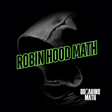Creation Myths and Scientific Chaos
00:00:00
Speaker
The void has always intrigued mankind. The concept of no concept defies the laws of human reasoning to such a degree that we have no choice but to pursue it. But ancient Assyrian, Norse, Judeo-Christian creation stories, and even our own scientific inquiries have one thing in common—creation from nothingness.
00:00:19
Speaker
But is it really nothingness? Anctions use the term chaos, and although to some chaos has become synonymous with bedlam or randomness, it has much more to do with the timeless myth of creation of form from the formless. So how does chaos take form? And is there meaning to be found in the apparent arbitrariness of chaos? Or is it a void that defines what we think it means to be?
Introduction of Speakers and Themes
00:00:40
Speaker
All of this and more on this episode of Breaking Math. Episode two, wreaking chaos.
00:00:54
Speaker
With us we have... I'm Charlie Shipley, I'm a freelance journalist and former writer for the Daily Lobo. This is Amy Lynn, joining you again. I'm a public school teacher in mathematics. I'm Hannah Butler, and I have a Bachelor of Science in Mathematics from the University of New Mexico.
Newton's Apple and Determinism
00:01:11
Speaker
And Gabriel, you're going to start a little bit with talking about physics and determinism? Exactly, exactly. Actually, this is really, really, really cool. I have the privilege of opening our episode on chaos with my own little story. I have a story about actually what got me interested in physics and math in the first place. This is a story that for a very long time I've been wanting to include on the podcast.
00:01:31
Speaker
Here goes nothing. Years ago, I was going to school to become a teacher, actually, and I was in a science class just for teachers. And I had a chapter that I was assigned to review. This chapter was on Isaac Newton. And after reviewing this chapter, actually, I thought it was so fascinating. It was so well written that I almost changed my major right then and there to physics.
00:01:56
Speaker
But my hope is that for our listeners and for our readers who follow the website They might have their own story about what got them really interested in physics So back to the story the entire chapter was on orbits and of course it described the story that many of us know about Isaac Newton and how
00:02:13
Speaker
you know, the apple drops from the tree and he wonders what is it about the earth that draws the apple toward it? And of course he formulates his idea of gravity by saying if you were Isaac Newton and you were to drop an apple from your hand it would fall
Physics, Free Will, and Chaos
00:02:26
Speaker
down. However, if you were to throw the apple it would travel a distance and then it would fall down. So let's pretend that you didn't have somebody like Isaac Newton but rather you had a Superman.
00:02:35
Speaker
who was much stronger than Isaac Newton. Let's say that he were to pick up that apple and he were to chuck it much harder and much further. It would travel much further along the surface of the earth before hitting the ground. Now, pretending, of course, that you didn't hit a mountain or a tree or a building, how far would it go before it would hit the ground? We know the earth is curved, so think about it. As that apple is traveling and as it falls down, it can fall as the earth curves. It's going to go a very, very far distance if you have someone like Superman throwing it.
00:03:05
Speaker
Hypothetically speaking, if he threw it hard enough, it would fall as the Earth curves and it would come back around and smack him in the back of the head. Of course, the whole purpose of this analogy is to describe in effect what an orbit is and exactly what the Moon is doing. The Moon is falling toward the Earth. It's just that it has an angular momentum with it.
00:03:26
Speaker
The force equals the gravitational constant times the mass of the two bodies, the Earth and the Moon, divided by the radius. Square of the radius. Yeah, the square of the radius. It's a very simple formula. And in this single formula, that describes the movement of the Moon around the Earth. That describes the- It's the square of the distance between them. Thank you. I'm sorry. Thank you. Thank you very much. Thank you. I got into my storytelling mode here. That simple equation explains the movement of the Moon around the Earth, the Earth around the Sun. That's every body in the universe, suddenly. So what does this have to do with chaos?
00:03:55
Speaker
Okay, here's what this has to do with chaos. In short, with Isaac Newton's math, we get what's called determinism, where if you know the momentum of an object in the initial directions, you can already predict the trajectory. In short, you can know the future of where it's going. The destiny. You can know the destiny. So on one hand, that's an incredibly cool tool. You're like, wow,
00:04:19
Speaker
I can now, you know, draw on a chalkboard, you know, like a cannon. And I know exactly where the cannonball is going as long as I know the initial mass and the initial conditions, etc. And you know that a million years from now. Yes, yeah, exactly. It's the same. Now, there's a darker side to this mathematics. There's a darker side to physics. The term where we're dancing around here is determinism. And philosophically, this is actually very, very uncomfortable.
00:04:44
Speaker
The idea of determinism is, okay, so if you know the initial momentum of something, and if you have enough information about the initial state, do you then know the future? Is there no such thing as free will? That's a very, very uncomfortable topic to broach.
00:05:01
Speaker
And as I recall, you were going to talk about the three-body system.
The Three-Body Problem and Chaos Theory
00:05:05
Speaker
Yes, absolutely. Absolutely. Because it's not so simple. That is where we introduce the concept of chaos, where you have three bodies all in orbit. And things are not as neat and tidy as we would like to have them in Newton's math. All right, Gabe. So let me stop you there for a moment, if I may. As somebody who understands nothing about what you just spoke of, you had me at darker side and determinism.
00:05:31
Speaker
So let me put it in terms of popular culture. Are you telling me that there is a mathematical equation that could have predicted whether or not Luke Skywalker would have joined his father on the dark side of the force? Let's say that we knew everything about Luke Skywalker, every atom in his brain, the direction they were going, and we knew them perfectly, which is impossible by the uncertainty principle, but that's for another episode.
00:05:53
Speaker
Yes. We would know if he joined the dark side, we know everything about Luke Skywalker's future. We would know when he ate a hamburger on what day, how many hamburgers he ate a thousand years in the future and so on. Then that's the daunting thing is the only thing about determinism is it just a matter of we don't know or that we can't know. And that's a really interesting concept. Do you have anything to add about the three body system?
00:06:16
Speaker
Right, so a lot of people started looking at the three-body system once they had figured out how to deal with the two-body system. And so kind of the main guy, the guy who contributed a lot to chaos is Henri Poincaré. So he was studying the three-body system or I guess more generally the end-body system with just kind of an arbitrary number of bodies.
00:06:41
Speaker
It happens to be impossible to solve. Big thing that Poincaré did was that he kind of approached the problem in a more qualitative way rather than a quantitative way. So rather than trying to predict the exact positions of bodies in the future, he asked the question,
00:07:03
Speaker
something like, is the solar system going to be stable forever or at some point will the planets fly off into infinity? And so this was kind of the first glimpse that people got into chaos, was working on that three-body problem. And this is kind of where they encountered things like sensitivity of initial conditions.
00:07:26
Speaker
And that, for most listeners, is the butterfly effect. Does the butterfly flapping its wings in Peru set off tornadoes in southern China? And we'll talk a little bit more about that later because the question is a lot more nuanced than a lot of people think.
00:07:40
Speaker
So right now what we're going to do, before we talk a little bit more about chaos, we have to acquaint our listeners with a concept called a vector field. And the example that I came up with as a simple example is the hair on your head.
00:07:56
Speaker
As wind blows, the hair goes in different positions. If you look at the hair as a bunch of arrows, it shows the vector field of the wind around your head. Actually, this is a really, really important topic. In my research, both as an electrical engineer in my graduate program, vector fields are a big, big thing. So I think the hair on your head is actually a really good analogy.
00:08:15
Speaker
Another good analogy, the one I always use is basically if you had a whole bunch of wind socks in a field and wind, a turbulent wind would blow, that's also a vector field because you've got all the arrows and you see where things are going at any given point. Now imagine we have the wind socks. We have an array of wind socks in 3D, just wind socks everywhere, basically a whole three-dimensional field of wind socks.
00:08:39
Speaker
You could tell where a particle would be going by following the direction of the wind socks at any given time. That's the cool thing about vector fields. They let us know the ultimate destiny of a point that starts. Wind, fluid, motion, all of these are described very well by vector fields. And we need vector fields to describe limit cycles.
Attractors and Limit Cycles
00:09:03
Speaker
Now, Hannah, would you like to describe limit cycles for our listeners?
00:09:08
Speaker
maybe before talking about limit cycles we want to introduce attractors. So an attractor is basically something, it could be a point or it can be a set of points, a line, a circle, that kind of everything around it is eventually going to move towards.
00:09:31
Speaker
So a limit cycle is basically circular or some sort of closed orbit that all of the everything around it is eventually gonna spiral into.
00:09:44
Speaker
For our listeners who would like to have a visual representation of a limit cycle, go to breakingmathpodcast.com slash applets.html. Due to the nature of this episode and due to the nature of getting our listeners acquainted with chaos, there may be a little bit of jumping around. It may be, dare I say, chaotic.
00:10:02
Speaker
having said that having said that just okay so we're following along here so in a chaotic system we've got a lot of moving parts when you talk about something like a limit cycle okay so that's basically the track that well let's say we have is it the track that the windsock moves on a little bit yes a limit cycle and a dust devil for a point might be the way that it moves around that's a limit cycle for a dust devil
00:10:25
Speaker
Why is it called limit cycle? Again, this is just for our folks who have never heard of the term. Well, because, OK, imagine we're storing a cup of coffee. If you if you put a grain of sand in the cup of coffee, you're going to be displeasing whoever is going to drink that coffee. But what the sand is going to do is it's going to go towards the middle until it goes to the center. In this case, the limit cycle is a point. It's called a limit cycle because where you start,
00:10:52
Speaker
Has sometimes nothing to do with where you end up and where you end up going So is it is it basically the parameters in which a given event occurs in a chaotic system in a chaotic system?
00:11:07
Speaker
So before we really talk about a limit cycle, I think we need to address what a limit is. And that we can't really do that in super technical terms because it is confusing in technical terms. But a limit is something that as you go on, as time goes on, as the variable gets large or as it gets very small, you approach some limit. There's some value that
Lorenz Attractor and Weather Systems
00:11:30
Speaker
you approach. So a limit cycle is what our system
00:11:34
Speaker
of the equations or if it's points that we're discussing or recording, it's what we're approaching. So that limit cycle could be any shape, it could be three-dimensional, it could be two-dimensional, but that is what we're approaching. A good example might be if you take one half of something, then add a quarter to it, then add an eighth, then add a sixteenth, and keep adding half of what you added before,
00:12:00
Speaker
the limit of that will be one. Just as a very simple example of a limit, would you say? Yeah, that's a good example. So yeah, so a limit cycle is what a piece of dust in the wind will approach doing. It'll approach going around a certain circle. But sometimes the cycles are strange in cases like the Lorentz attractor. Hannah, would you like to introduce why the Lorentz attractor was conceived in the first place?
00:12:27
Speaker
Really quick, the Lorenz Attractor doesn't have any limit cycles. Yeah, it doesn't have limit cycles, but it's an example of an attractor and when limit cycles basically fail. Yeah. Okay, so the Lorenz Attractor kind of came up when Edward Lorenz, he was kind of studying the weather and atmospheric patterns.
00:12:47
Speaker
As far as atmospheres patterns go, there's kind of an infinite number of variables that we can consider. And so what he did was he simplified it as much as he possibly could, and he just kept simplifying it until he kind of reduced it to three variables. And for those who would like to know exactly how he reduced it, you can find that on breakingmathpodcast.com slash papers.html.
00:13:14
Speaker
When he simplified it, he still found that when you started at a certain point, that basically you'd still get this kind of chaotic behavior over a long period of time. And as I recall, the story of him discovering the butterfly effect with his attractor was an input error. He started with an input and had a certain amount of decimal places, but he transposed two of the decimals.
00:13:42
Speaker
And then when he graphed it, he found that the system went wildly different than it did when he started. So he found out that there was an extreme sensitivity on initial conditions. Since you could imagine this sort of sensitivity in real life, just imagine a butterfly flies into your car, distracts you, you crash into the side.
00:14:02
Speaker
of the road. This is an extreme example, but this is what sensitivity on initial conditions means. So you said inherent fragility in situations. Does that mean that all situations are inherently chaotic?
00:14:18
Speaker
Not all situations are inherently chaotic. Or most situations have the inevitability of chaos? Is chaos an inevitability in anything? It is not known. It's a very recent field. It's not known exactly what causes chaos. It's known that it happens when you have more than three variables in a lot of conditions. That's a gross oversimplification. However, an example of a system that's not chaotic is a canon.
00:14:48
Speaker
You fire a cannon, you fire it a little bit more, you get a little more distance. You fire a little less, you get a little less distance. That's not a chaotic system. But wouldn't variables in, say, the gunpowder or the condition of the cannon or the condition of the ball, wouldn't those fall under chaos? They could fall under chaos. The more variables you add to the system, the more likely it is that you will run into chaos.
00:15:10
Speaker
Yeah, I think with standardizing things, then that also limits those variables, or at least it attempts to. But I mean, that's actually a very good question. Again, just for identifying what's chaotic versus what's not. And actually, the whole story of Lorenz, that's a fascinating story. I love that story. You actually touched on this before. So again, you mentioned that he was making a simulation, or I'm sorry, he was running a simulation, and the simulation was for the weather, correct? Yes, it was a simple simulation. It assumed that all weather was homogeneous, basically.
00:15:40
Speaker
and only had three variables. Yeah, so basically his extreme oversimplification of it, you know, only three variables. Now really, there's a lot more than three variables with weather when you think about it. There is, gosh, how many can we name off the bat? There is temperature, there's humidity, there is... Time. There's time, there's...
00:15:58
Speaker
There's pressure, there's viscosity, there's, I mean, just anything in the fluid dynamics equation. That's an obtusely, that is a very complex system. So really he just whittled it down to just three. But even whittling it down to these variables, he still found very complex behavior.
Chaos Theory in Pop Culture
00:16:15
Speaker
Now tell me again, this part I find fascinating. This is what really led to the whole story about the butterfly effect. So in his simulation, you mentioned something about he, I'm sorry, was it he misplaced two decimals? Yes. He wrote, when he was putting it into the computer, he wrote it down a little bit wrong and it was a bunch of decimals into the thing.
00:16:33
Speaker
Now, if I remember correctly, it was a very, very, very insignificant decimal. It wasn't even the 100th place. It was like the... It was probably in the 10,000th or 100,000th place. It was very small at this point. So then in short, you were in the simulation, right? And he maybe misplaced a very, very incrementally insignificant digit in this little simulation on the weather.
00:16:56
Speaker
Then you run the simulation. And then, you know, the next day he looks at his results and they are wildly different than what he thought of. That's why weather prediction is so difficult. It's a chaotic system. Anything more than a week and a half really is completely unreliable.
00:17:15
Speaker
That's just amazing. It shows how significant this fragile system is. If you want to talk about some pop culture examples, things like Back to the Future where you've got small changes will have massive effects.
00:17:28
Speaker
You know, I think that's right. But I I don't know. I mean, I'm sure Jonathan here could find a mathematical model of Marty McFly sleeping with his mother and negating his own existence. You know, upon further introspection, that's actually some math I'd like to see. But, you know, I think a more pertinent example, particularly because the author of the source material was so passionate about mathematics and science and economics and all that kind of thing would be Jurassic Park.
00:17:58
Speaker
Anyone who's ever read the original novel as well as the sequel novel The Lost World will find that between the chapters are fractal curves depicted as if done by computer simulations.
00:18:13
Speaker
You know, of course, for those not aware, Jurassic Park had introduced a character named Dr. Ian Malcolm who billed himself as a chaotician rather than a mathematician played by Jeff Goldblum, and he used the mathematical concept of chaos to illustrate why and how Jurassic Park
00:18:33
Speaker
would not and could not work. He summed it up in the eloquent line, life will find a way. And when we look at the events that happen in that movie, you know, we will see that I think the inherent fragility of situations comes into play very startlingly, not only with
00:18:53
Speaker
the tour group itself, but even as far as the beginning of the tour where the Dilophosaurus failed to show up, then you have the sick Triceratops, then you have the weather coming into play, then you have unscrupulous employees playing with the security system. So I think the movie itself is actually a
00:19:14
Speaker
very appropriate example of chaos. And one thing that you brought up, and this is what we're going to discuss a little bit next, is that although there may be sensitivity on initial conditions, a butterfly is as likely to create a tornado 100 years from now as it is to prevent a tornado 100 years from now.
00:19:34
Speaker
And not only that, but the flaps of a butterfly's wings cannot change the frequency of tornadoes, only the order in which they occur. If Universe A has tornado, hurricane, tornado, hurricane, hurricane, tornado, Universe 2 might have three tornadoes, a hurricane, and then four more tornadoes. That's the way in which chaos works, and it's a lesser-known property of the butterfly effect.
00:19:57
Speaker
Now, Jonathan, something you mentioned is universe A and universe B. Now, this may be two inside baseball or two off the rails, but what about the parallel universe or many worlds theory? Do alternate universes or the theory or possibility of alternate universes affect the mathematics of events in this universe?
00:20:20
Speaker
That's going off a little bit on a tangent. What I can say about that is that the inaccuracies inherent to just measuring any material, the uncertainty principles, which says that the more you know about momentum, the less you know about position, means that any chaotic system will have inherent unpredictability just because of that.
00:20:46
Speaker
Rabbits and foxes have a relationship which is too well known to be restated, but we will anyway.
Predator-Prey Dynamics and Cycles
00:20:51
Speaker
Foxes eat rabbits. But how many rabbits? When there are not many rabbits, the foxes starve. The rabbits see this as an opportunity and multiply. In response, the foxes prosper and the yearly cycle continues, yearly because rabbits have mating cycles annually. But it turns out that this is not the whole story. When you start with certain proportions of foxes to rabbits, it could take two years for the cycle to repeat
00:21:15
Speaker
and with other proportions it could take 8 years for the cycle to repeat, and so on. This is the reason why you have phenomena in nature like cyclic plagues. The cyclic nature of events is an essential and as yet unproven property of chaos. Empirically, however, it has not been with exception, and that is why it is included in the mathematical canon.
00:21:34
Speaker
If you had a proper chaotic system controlling a Ouija board, for example, there's a starting position for the pointer that will spell out every word, every sentence, and indeed every book ever writable again and again until the end of time. This is the nature of chaos. It preserves information, but only the information that it is given. How is this different than determinism? How do we have to change the way we look at things because of this new world view? Now we're going to talk a little bit about the rabbits and foxes example. What's the name for that technically? The Lotka-Volterra model.
00:22:05
Speaker
And how is that an example of a limit cycle?
00:22:10
Speaker
So starting at certain points or starting at certain population, certain initial population of rabbits and foxes, they managed to kind of keep each other in check. Whereas when we get too many rabbits, the foxes will prosper and they'll start eating all these rabbits, but then they'll run out of food. And then the foxes will start to die off. And then in response to that, the rabbits will start to multiply and their population will grow and we'll kind of have this
00:22:37
Speaker
this balancing act between rabbits and foxes that just goes around in a cycle again and again and again. And that kind of cyclic behavior is an example of a limit cycle.
00:22:52
Speaker
So could it be said that the cycle of evolution and survival of the fittest is just a giant limit cycle? It's full of limit cycles. The way that they interact is highly non-linear. Evolution in life is an example of a non-linear system. It's a very good example of one because just looking at humans and the fact that we're able to simulate any non-linear system means that it's non-linear.
00:23:15
Speaker
But attractors are essential to the way that we look at chaos. An attractor is, it's an object that has a certain limit that it goes around. And I'm going to play a sound example of an attractor known as a loron's attractor.
00:24:00
Speaker
Okay, so do we want to explain exactly what it is that our listeners just heard? That was a La Ronze attractor by Edward Van Halen. Well, what that was is... Edward La Ronze, thank you. ...is an example of a chaotic system. And the reason why it's chaotic is because when you take two very similar starting points, they end up in completely different
Differential Equations and Chaos
00:24:20
Speaker
positions. And we'll play an example of that right now.
00:24:45
Speaker
What do the different tones represent for our listeners?
00:24:48
Speaker
The amount of a square wave is the x direction, the volume is the y direction, and the frequency is the z direction. So if you go in one direction, it goes ooh. If you go in another direction, it goes ooh. And you go in the other direction, it goes ooh.
00:25:07
Speaker
So those are the three directions. So in the first sound that we heard, it was just kind of one sound and it sounded kind of weird, but it was just one sound. But in the second, you could hear them start at slightly different kind of tones, I guess. But as you played it for longer, you can hear that they're starting to move away from each other. Yes. So what do those two different like tones represent?
00:25:29
Speaker
Those tones represent different points in 3D space. And you can hear that they have the same... They go around the same sort of cycles, but they go around them in different orders at different times, different distances away from the center. It's a sonic representation of a strange attractor.
00:25:50
Speaker
So for our listeners, the Lorentz system, the Lorentz equations, it's a system of three differential equations, which we won't get into that necessarily right now. But it's actually three fairly simple equations that, given certain parameters, we have a behavior that is described in three-dimensional space, so x, y, and z in mathematical terms. So we have a point moving in space, and it's circling around, depending on the parameters. The classic example is that it's kind of circling around two distinct
00:26:20
Speaker
centers, but it's kind of, it's rotating around each of those. And so what you've created is something that describes in those three dimensions, given those three parameters, the location of that line as it's growing in space. Yes, and for our listeners, a simple example of a differential equation is driving. When you have the wheel at two o'clock, the wheel is not moving, but the car keeps turning. You move the wheel back to 12 o'clock and the car goes in a straight line.
00:26:49
Speaker
In this case, the position of the car is a differential equation of the position of the wheel. If you were to somehow make the wheel tied to the speedometer, you'd get a real sort of differential equation. But yeah, that's the sort of complex system we're talking about.
00:27:06
Speaker
Can I give my example of what a differential equation is? Absolutely. So a differential equation in simplest terms is something, it's an equation that contains a variable and its derivatives. And if you think about it in real examples that the derivative of position is velocity, the derivative of velocity is acceleration. So if I had an equation that talked about the velocity and the position of my car, that's a differential equation.
Deterministic Yet Unpredictable Systems
00:27:31
Speaker
And of course, the derivative of the position of the car is on, like you said, on the speedometer, it's the rate of change. That's what a derivative is. Right. So in that second sound, at the very beginning of that, how did those two tones differ from each other? They differed by a factor of 0.0001. Just to give you an example of how small that is in terms of the attractor, they go from about negative to positive 30.
00:27:57
Speaker
OK, so they're really, really, really close together. Very close. The fact that we could hear them says a lot more about how sensitive our ears are than how different they are. But yeah, so the point, though, is that they were really, really close together. But then as time went on, they started sounding really, really different. Yes. Why is that?
00:28:17
Speaker
It's because the Lorentz attractor is a chaotic system. It's sensitive to initial conditions. An example of a system which reduces to the Lorentz attractor is multiplying by 2 and then truncating when you get more than 1.
00:28:32
Speaker
to elaborate, start with a number like 0.2, you double that, you get 0.4, 0.8, then 1.6, but then you subtract one because it's more than one, you go to 0.6, and then you go back to 0.2. So then your cycle there is 2, 4, 8, 6, 2, 4, 8, 6. And every single cycle on the La Ronza tractor has an equivalent cycle using this doubling and truncating by one example.
00:29:00
Speaker
Right, so that first one, the sensitivity to initial conditions where if we don't start in exactly the same place, if we have two guys that are starting at slightly different places, they're going to move away from each other at an exponential rate over time. Along with that, we also have that chaos has aperiodic long-term behavior. We're never going to repeat the same pattern ever.
00:29:29
Speaker
Well, we could repeat certain patterns. It's like the natural numbers versus the irrationals, but in general, it's completely aperiodic. Yeah, very rarely are there periodic trajectories in a chaotic system. And like we talked about in the last episode, there's a lot less rational numbers and there are irrational numbers.
00:29:51
Speaker
So does someone want to describe the difference between periodic and aperiodic, or just tell us what periodic is? Periodic is like a, b, a, c, b, b, a, c. A, b, c, b. Yeah, so you lost the pattern already. Yeah, I lost track. Something that is periodic is something that repeats periodically, right? So it's something that has a periodic pattern. So something that is aperiodic, something that's chaotic, is going to be something that has no discernible, or it may have a pattern, but it's a non-repeating pattern, right?
00:30:20
Speaker
I think chaos doesn't even have any kind of discernible pattern, right? In general, no. Not at all. Which is why it's chaos. Right. But irrational numbers can have a pattern so long as it doesn't repeat. I think that says a lot about the world that there are more irrational numbers than rational ones.
00:30:39
Speaker
Just let y'all chew on that for a minute. That was profound. It really does though, but that's a topic for our Math and Intuition episode. All right, so chaos. So something a chaotic system is what we generally discuss, right? So what are other important characteristics of a chaotic system?
00:30:59
Speaker
So, we have the sensitivity to initial conditions, we have the aperiodic long-term behavior. A chaotic system is always deterministic, which means that if we know exactly where we start, we're always going to be able to predict where it will be anytime in the future. And that's it. But you need to know exactly. You need to know exactly. Exactly. You can't have an approximation and be like, that's good.
00:31:23
Speaker
So, because of that sensitivity to initial conditions, if we don't know exactly where we're starting, then that point that's not exactly where we want it to start is going to move away exponentially fast.
00:31:36
Speaker
Real quick, I wanted to point out that we had started off this discussion with the idea of the cold, hard determinism of Isaac Newton's math, and then we went to chaotic systems.
Mathematics, Philosophy, and Chaos
00:31:46
Speaker
Now, chaotic systems are deterministic, in fact. It's just that with the- Not in practice. Okay, and can you clarify how- In theory. Okay, so then for our listeners, again, if they're trying to understand this and if they're trying to describe, I'm hoping to get some clarification with how it's deterministic in theory, but not in practice.
00:32:06
Speaker
Sure, it's deterministic in theory just because we could simulate it on a computer. I mean, that's just one kind of like piece of evidence that points towards it if we didn't already know it. If you know exactly where it starts, you could continue it. However, if you don't know... Okay, let's take the weather, for example.
00:32:24
Speaker
Let's say that we had a measure of every component of weather at every square foot on the entire planet. Within three weeks we would not be able to predict what the weather turned into because it's a chaotic system. It depends so much on initial conditions that even an approximation as good as one measurement per square foot would not be enough to tell us about the fate.
00:32:47
Speaker
of the weather. Okay, that's mind-blowing. So, wow, literally, so you had one, I'm sorry, it was a radar? One radar per square foot? One radar that measured, like, you know, humidity, everything. Okay, so one radar, and if you could measure every single variable, the maximum you could go is three weeks? I mean, the maximum you could go really, like, to any appreciable degree is about three weeks. Okay, okay.
00:33:10
Speaker
So then I guess my question is we still do live in a determinant from a philosophical perspective. We still do live in a deterministic universe. We just don't know what that destiny will be. Essentially, yes. I mean, there's a little bit of philosophical disagreement about what what the uncertainty principle means, but that's a discussion for another time. OK, OK, I just wanted to clarify. I'd be interested to know how closely chaos and philosophy relate to each other.
00:33:38
Speaker
very, very closely. Math and philosophy are completely interconnected. Brilliant question. Also, it's a phenomenal plug to other episodes. Math and consciousness, that's going to be a big one. Math and logic? Yes, math and logic. Oh, yes. We have our huge episode that'll be coming up in several episodes. Consciousness, we have an entire episode on proofs and philosophy coming up pretty soon. Nice, nice.
00:34:01
Speaker
One of the things that I find interesting about a chaotic system is that we've kind of given up on realistically trying to estimate, but we still can predict weather patterns.
Weather Prediction Challenges
00:34:11
Speaker
And the way that we do that is by modeling chaotic systems and looking at probabilities and looking at what's happened in the past and what conditions have led to others. And I find that pretty interesting.
00:34:20
Speaker
Yeah, we know there's going to be a hurricane season, for example. Right. We keep mentioning the weather when talking about chaotic systems, but what about the political system? Could that also be ... Now, I'm not saying any names. I'm not naming any names. I'm not speaking of any particular thing that just happened on November 9th.
00:34:40
Speaker
But theoretically, you could relate the political system to chaos as well. Any nonlinear self-referential system lends itself to chaos eventually. Good example. And we have a few other examples of chaos. Imagine you're at the state fair, riding a Ferris wheel, when all of a sudden there's a torrential downpour.
00:35:02
Speaker
But the cloud is only about 20 feet wide and is raining only on the highest spot on the ferris wheel. The power because of the shoddy construction cuts out and some of the carts under the downpour start filling with water. They're leaky, so some of the water leaks out. The ferris wheel starts turning their way because they're heavier. However, the more ferris wheel turns, the more carts get their chance to be filled with water and starts turning the other way. Now our question for you is this, which direction does the wheel turn ultimately? The answer, which may not surprise you at this point, is that it'll turn back and forth
00:35:32
Speaker
forever, aperiodically, in a way that is essentially unpredictable. One degree or even a hundred thousandth of a degree of distance between two different starting positions could mean the difference between being at the top and the bottom of the Ferris wheel in a very short period of time. Something really interesting about that situation is that Lorenz's simplified atmospheric model perfectly models the Ferris wheel problem.
00:35:58
Speaker
Yes. And it wasn't the motivation, the fact that people criticized his model for being too unrealistic and having nothing to do with reality. Mathematicians always hear that. So again, I believe we said this earlier, but just to clarify for our listeners. So even Lorraine's simplified model with three variables, we still have no idea how effective that is in terms of modeling weather. Like we do not know, we don't know if it's completely ineffective and we don't know if it's effective. Is that right?
00:36:23
Speaker
Yeah, I mean, I know that certain configurations of beta and alpha correspond to perfect convection and so forth, but I don't know what those are. I don't know enough about fluid dynamics to comment on
Fractals in Nature
00:36:35
Speaker
that. Interesting. We wouldn't be able to understand it anyway, so that's okay. That sounds like a challenge.
00:36:44
Speaker
So now that we have a few examples of chaos, does anybody else have any examples they would like to bring up of chaos, chaotic systems in general?
00:36:55
Speaker
I'd like to pose a question. Earlier, we were joking about Back to the Future and Marty McFly. Now, one of the things that I believe Hannah was saying about the Lorenz Attractors was you had to know the precise conditions at any given time. Now, earlier Gabe had mentioned Back to the Future and this actually relates more than I realize now because in that movie,
00:37:24
Speaker
They knew exactly when the lightning bolt was going to strike at 10.04 p.m. to send Marty back to the future. Now, I thought I knew where I was going with this, but just to kind of put a bow on it, is that something that's in the realm of possibility in the real world? Can we actually know exactly when something is going to happen down to the minute, or is that a figment of Hollywood?
00:37:45
Speaker
That's a figment of Hollywood, I'll tell you why. I've done the Lorenz attractor with 0.000, like 20 zeros and then a one of difference, and it does always split up, no matter how close they are. Sorry, guys, I thought I had more. The problem is we can never possibly know everything, right? That we are butch-meared humans, and we can't possibly know every possible condition in our universe. That's why weather is the prime example of the chaotic system, because we can't ever know exactly everything.
00:38:15
Speaker
The uncertainty principle states that there's always going to be something that we don't know about the position of something if it's moving quickly and vice versa. It's XP minus PX equals H bar. That's Heisenberg? That alone brings up a huge amount of philosophical questions about physics, which we will get to on a future episode.
00:38:39
Speaker
Open up a Russian nesting doll and you'll find a smaller one. Open up that one and you'll find a smaller one than that. If this process could go on forever, you'd have a fractal. A fractal is anything that you could zoom in on and continue zooming in on and always see detail. In this way, chaos and fractals are very similar. In fact, you can make fractals out of many chaotic systems very easily by graphing starting positions.
00:39:03
Speaker
One property of many fractals is self-similarity. Take trees, for example. A branch looks like a miniature tree, and each branch on that looks like a smaller branch. This is not an essential property of fractals, however, but fractals are found everywhere in nature, from coastlines to the circulatory system to rivers and clouds. If chaos is a language of nature, then fractals are the words in which it is written. So how do we read those words, and what can we learn from doing so?
00:39:29
Speaker
So fractals, how can we make sense of what fractals are? Of course, they have infinite detail, but what does that essentially mean? So as far as chaotic systems go, so chaotic systems do have attractors, but rather than the attractors being like a fixed point or a limit cycle, the attractors are fractal sets. So all of these trajectories are attracted to a set that is a fractal.
00:39:54
Speaker
The attractor is essentially the behavior. Right, so that butterfly shape of the Lorenz attractor, that's a fractal, because you can zoom in as much as you want, and it'll keep repeating and repeating. It's just infinite amounts of folding and folding. So it's still a chaotic system, but it's one that repeats a behavior rather than repeating a specific place. It repeats a pattern, kind of. Well, I mean, my introduction to fractals was not in the pictures, it was in the fractional dimension aspect.
00:40:23
Speaker
I never really saw the connection between chaos and fractals. I guess by behavior, I mean it's that self-similarity, so it continues to make the same shape. Yeah, so as you zoom in, it's just going to be the same thing over and over and over again. It'll have structure at arbitrarily small scales. So in that sense, the fractal, the shape, is the attractor.
00:40:43
Speaker
The shape, yeah. And here we have an auditory example of a fractal. This is just the Mandelbrot set, which we'll describe in just a minute. And we'll play this and we'll be right back.
00:41:27
Speaker
So again, can you describe what those sounds represent? Yes. The pitch represents the Y axis. The time represents the X axis. And basically what this is is a picture of the Mandelbrot set made into sound. And the reason why I played it is if you listen back, there is a lot of little tiny details that you could hear.
00:41:50
Speaker
Now, any representation of a fractal that's finite cannot represent that fractal. However, you can see that it's becoming a fractal. And one way of doing this is by just showing you how to draw a very simple fractal. It's called the Sierpinski triangle.
00:42:08
Speaker
Let me talk about that. The Sierpinski triangle, or the Sierpinski gasket, is a representation of one of the coolest math moments I ever had. If you think of a triangle that is filled in, so you have a whole triangle, and you cut out the middle fourth. You cut out a triangle from the middle, you take it away, and then you continue to do that to what remains. I take out the middle fourth of the three triangles that remain, and then I take out the middle fourth of all the little triangles that remain.
00:42:34
Speaker
that if you do that infinitely many times, what is left? You have taken away all of the area, right? This is the nature of infinite. But we've left all of the end lines, right? And all of the points where it connects. What is left is equivalent, it's dense, right? Which is a mathematical term that we may describe later. But we've taken away the area, so it no longer has dimension of two, but we know that it has dimension greater than one.
00:43:01
Speaker
So that is where we get the term fractal, a fractional dimension. We've just created something that's fractal that has a dimension between one and two. Yes. Imagine you have a yardstick and want to make it twice as long. It's simple. It's now two times as long. Now let's say you have a yard and you want to make it so that you have to walk twice as far everywhere in between the yard. The yard is now going to be four times as big as the yard was before. And if you have a room where you want to make it twice as big in every dimension, it's eight times as big and so on.
00:43:32
Speaker
Now, let's think about this Sierpinski triangle that Amy just described. When you double it, you get three times as many. You don't get four, and you get more than two. Remember, two is a yardstick, and four was something two-dimensional. And it turns out that it's around 1.58 dimensional. Wrapping your mind around fractional dimensions is, of course, daunting, but that's the way of measuring it, and you can even measure the coastline of England this way.
00:44:02
Speaker
This triangle is just nuts. Actually, while you guys are talking about this, I am here at the Breaking Math website, and I'm looking at the applet right now. It's absolutely mesmerizing watching this Sierpinski triangle form itself. I could just look at this forever. And I gotta say, I'm sure I'm not alone in this, but among our viewers, I'm not the only one who cannot wrap my mind around 1.58 dimensions. That doesn't compute. I only think of dimensions in whole numbers, sorry. That's just mind
Mandelbrot Set and Complex Numbers
00:44:29
Speaker
-blowing. That's given me a lot to chew on.
00:44:32
Speaker
That's why it was one of the most like mind-blowing moments of mathematics for me that that mine was actually the Cantor set which is the between zero and one dimensions and the proof that that is it has to be between zero and one was just so Amazing to me. Yeah, and for a more mathematical minded listeners. It's log 2 divided by log 3 and
00:44:54
Speaker
Again, talking about parallel dimensions, when you think in terms of numbers that small, that to me is good evidence for the many-worlds theory. It might be. And we'll totally discuss that on the physics episode. And real quick, I do want to give an example that Hannah brought to my attention of a fractal that is not self-similar.
00:45:21
Speaker
divide a square into nine pieces, take away a random piece of that square. Now with the remaining eight squares, divide each of those into nine pieces and take a random piece out of every single one of those. And keep doing that with the resulting squares. You're gonna get something that has an infinite amount of detail but is not self-similar at all.
00:45:40
Speaker
When we say the word fractal, what you're probably picturing in your mind is the Mandelbrot set. That's probably what you imagine. That's probably the most famous fractal in the world. It's again, it's a fairly simple system. It's a simple construct to create it. But before computers, we could never visualize it. And so that's what was really impressive to me about fractal theory is that it very much came before we could see where it was going. But as soon as we could see where it was going, we're like, holy crap. It's so pretty.
00:46:10
Speaker
Exactly. Yeah, and it sounds weird too. Can we real quick go into a little bit of history of the Mandelbrot set? Well, if you're mathematically minded, imagine the complex plane. Basically, that's where y is the imaginary component, x is the real component. So that's a big topic in and of itself.
00:46:31
Speaker
We are all accustomed to the real number line. I think we've all learned that in elementary school. We think about positive and negative numbers being centered around zero on the real number line. That the complex plane, which was something that was fairly, it was really scary at the time. They didn't want to admit that complex numbers existed. So we introduced that we are no longer thinking of numbers as one dimensional. That the line, the real number line, was not sufficient.
00:46:58
Speaker
for the mathematics that we wanted to do. So they said, you know what? I need to be able to take the square root of a negative number. I'm just going to call it I. And that number, it's a number. It's totally legit. And they made fun of him and said, yeah, those are imaginary. You're full of crap. And you can take the square root of I. It's just square root of 1 and 1 by 2 plus square root of 1 by 2 times I.
00:47:24
Speaker
But again, I is the square root of negative one, which all throughout school they tell us you can't take the square root of a negative, right? That was just a fact that we were told. The mathematician who said, I need to be able to take the square root of a negative number, that it's really important to electrical engineering and the way that circuits work.
00:47:40
Speaker
that imaginary numbers do have to exist. So I prefer to call them complex numbers. We call it the complex plane. And really all it means is that we're going from a real number line, which is one-dimensional, into a complex plane, which is two-dimensional. But we're still just talking about numbers. Yes. Of course, it has the property that if you take b times i and multiply it by c times i, you get negative bc because b times c times i times i, and i times i is negative 1.
00:48:09
Speaker
But just for a quick mathematical description of the Mandelbrot set, what it is, imagine you have a point. What you do is you take a number, square it, add c to it, and then keep doing that over and over again. If it goes to infinity,
00:48:24
Speaker
then it's not part of the set. If it settles on a certain number, then it is part of the set. And that's just our technical description. It's not necessary for an understanding of fractals in any way, but it's interesting. Something that goes back to the point that Amy just made perusing the Wikipedia entry on
00:48:40
Speaker
imaginary numbers here and one of the things it says is originally coined in the 17th century as a derogatory term and regarded as fictitious or useless. I mean even Descartes thought that negative numbers were fictitious and useless. The original Cartesian coordinates did not have a negative component. My students still stand by that statement. I kind of want to go back to my math classes and say I think all of this is fictitious and useless. I demand that we redo my grades.
00:49:06
Speaker
So the Mandelbrot set is in the complex plane. It's a very simple equation that you take, and it's something called an iteration. So you take the previous term, you square it, and add a number to it, and that is the next term, right? And so you continue on in that pattern, and that produces a set of numbers which creates what we all recognize as the fractal, the Mandelbrot set. Yeah, and it's interesting how much just the study of fractals and chaos in the last century
Impact of Chaos and Fractals
00:49:33
Speaker
kind of completely changed the way that we view systems in general. Bifurcation diagrams, which Hannah mentioned earlier, are an iterative process. Well, they happen because of iterative process. But if you look at the original paper, he thought that it was gonna be something very easily predictable. If you Google bifurcation diagram, you'll see how complex they are. Yeah, it's changed the way that people view
00:50:01
Speaker
Everything there's tons of movies called the butterfly effect Everybody knows about the butterfly effect. Everybody understands that fractals are a thing Yeah, it's just a It's changed the zeitgeist now we explored the consequence of chaos the properties of fractals
00:50:20
Speaker
and the nature of these complex systems that make up our world. And the field is new, less than a century old. As the systems we use to analyze them grow more complex and our understanding of these processes becomes more nuanced, the influence that these sorts of systems will become better understood and the ways in which we can use them to build our world will only become more fruitful. I'm Jonathan. And I'm Gabriel. And this has been Breaking Math.
Conclusion and Guest Affiliations
00:50:43
Speaker
Today we had on Amy and Amy, would you like to plug anything?
00:50:48
Speaker
I work for the Public Academy for Performing Arts. It's an APS charter school. Go charter schools. Go Papa. We're raising money to get a performing arts center at our school to serve a need, as charter schools do, to promote performing arts in New Mexico and Albuquerque for these wonderful students. Support your local charter schools. We also head on Hannah today. Hannah, would you like to plug anything?
00:51:12
Speaker
No. Math is awesome. Math is awesome. And Charlie, would you like to say anything? I'd like to thank you all for having me. And this has been a very informative discussion. I want to thank you for indulging my attempted insertions of popular culture into our discussion of mathematics. And I look forward to hearing the final podcast. Awesome.
00:51:59
Speaker
Thank you for listening to Breaking Math.




















